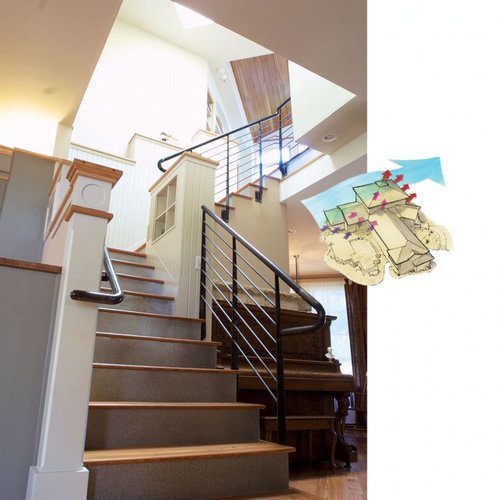ABOUT GREEN MECHANICAL SYSTEMS
The primary job of the mechanical system is to deliver comfort to people: warm air, cool air, hot and cold running water. Mechanical system parts include everything that has pipes, wires, or ductwork.
Green mechanical systems don’t waste energy or water and they keep the indoor air fresh. They do all of that because they’re designed to work in well-insulated and tightly built houses. Mechanical systems aren’t independent stand-alone systems; the design of the plumbing and electrical systems and the type and size of the HVAC system depend on a range of factors including the building envelope, the climate, the size of the house, orientation, etc. Even with a tight, efficient envelope, a structure won’t reach its efficiency potential unless the mechanical systems are chosen and installed properly.
Give equipment a chance to work efficiently. Air conditioners and air-source heat pumps have outside heat exchangers that rely on a free flow of air. When the equipment is boxed in by a small enclosure or trapped behind dense foliage it won’t work as well.
Base equipment choices on ACCA manuals, not estimates. Some HVAC contractors, especially those who have been in business for a long time, may be tempted to size heating and cooling equipment by educated guess. Over-sizing equipment is common. Systems should be designed with the help of three essential guides from the Air Conditioning Contractors of America: Manuals J, S and D. They cover heating and cooling loads, system size and duct design, respectively. Systems that are designed with these calculations in mind will run more efficiently and save energy.
Computer simulations are another option for calculating cooling loads.
##MORE ABOUT GREEN MECHANICAL SYSTEMS
Mechanical system parts
Mechanical systems consume energy and natural resources during the lifespan of the house, so your choices should be guided with an eye toward conservation.
Heating systems keep people comfortable in winter, heat water, and do so efficiently. The type of heating system can be based on the type of space to be heated, the climate, and available fuels.
Cooling systems are optional, but when specified must be properly sized to insure that the system operates efficiently. Green choices include ceiling fans, whole-house fans, or evaporative coolers. Houses that include air conditioning should choose energy-efficient systems that use refrigerants like R-410a that don’t have the potential to harm the ozone layer. Oversized equipment doesn’t operate properly in a tight house, resulting in cold, clammy air.
Mechanical ventilation. Insulation, windows, orientation, and shading affect mechanical equipment performance and operating costs. To keep a living space healthy, however, a house with a tight envelope needs mechanical ventilation to bring in fresh air and expel stale air, humid air, or air filled with contaminants. Greener ventilation systems include heat recovery.
Plumbing systems include both water supply and waste water; most opportunities for improving performance are on the supply side. Use low-flow fixtures to conserve water and in arid regions especially consider plumbing the system to use gray water for irrigation.
Electrical usage can be reduced by selecting efficient appliances and lamps, reducing phantom loads, and incorporating day-lighting strategies that reduce the need for artificial light. Once these measures have been performed, photovoltaic modules or a wind generator may be worth considering.
Bird’s eye view

Image Credits: Don Mannes/Fine Homebuilding
Over its lifetime, a house and its occupants use a huge amount of energy and water. Good mechanical systems can help conserve
Using less water and energy is good for the environment and public health and lowers the cost of living in a house. The energy and water used by a home over its lifetime dwarfs the amount used to build it, so efficient houses can have a very lasting effect.
In a tight, super-insulated house, mechanical systems need to be sized right. Green homes have efficient equipment to provide heating, cooling, and domestic hot water. Ideally, heating and cooling equipment will rarely even operate.
Green plumbing systems use a water-conserving layout, waste-water heat recovery, and gray water recovery. Clothes washers and dishwashers, if any, are highly efficient.
Rather than relying on a leaky shell for “fresh air,” green homes use mechanical ventilation to deliver fresh air and take away stale air. There’s no mold in a green house because the moisture level is right for people, wrong for mold.
See below for:
Energy Savings

All of the systems can work together to use less energy
The mechanical systems distribute water and energy. If the design is thought-out, the mechanical systems will perform very efficiently, so they won’t waste as much energy as regular systems. Mechanical equipment works most efficiently in a tightly sealed, well insulated house.
There are several ways to cut energy use — air-conditioning equipment, appliances, lighting systems, even plumbing layouts can save energy. The mechanical system offers a lot of possibilities for improvement:
- If possible, unnecessary HVAC equipment should be omitted — for example, a central air conditioner.
- Necessary equipment should be sized right, since oversized equipment is more expensive to purchase and may be less efficient to operate.
- Chosen equipment should be the most efficient permitted by the budget.
- Equipment should be designed to recover energy leaving the building (for example, in exhaust air or plumbing waste pipes). Options include heat-recovery ventilation (HRV) and drain water heat-recovery devices.
Efficiency first, renewable energy second. After the envelope is tight and the demand for power has been cut down, some homeowners may want to consider the installation of photovoltaic panels, solar water heaters, or wind generators. In most cases, however, energy conservation is far more cost-effective than energy generation.
Water Savings

Save water by building the right system
There are several ways to ensure that mechanical equipment helps save water:
- If possible, unnecessary equipment that uses water should be avoided.
- Necessary equipment should be sized right.
- Equipment should be designed to use water efficiently.
- Equipment or fixtures that use water should be used as little as possible.
- Where appropriate, equipment should be designed to recycle water.
Clean Air

Image Credits: Daniel Morrison / Fine Homebuilding
Clean air comes with a tight house, no fumes, and good ventilation
For a green building to have clean indoor air:
The building’s shell must be as airtight as possible.
Combustion devices, such as the furnace and gas water heater should be power vented or sealed combustion to avoid backdrafting.
Indoor finish materials that outgas harmful fumes should be avoided.
The building’s ventilation system must exhaust air from rooms with sources of air pollution.
The building’s ventilation system must provide and distribute adequate amounts of fresh outdoor air.
###WHAT’S RIGHT WITH THESE PICTURES?
The interior surfaces promote clean air:
• Wood floors are easy to clean.
• No carpet for dust mites to colonize.
• Low-VOC paint.
• Solid-wood furniture (not particleboard).
• Range hood is vented directly outside.
Fresh air throughout the house:
• Cathedral ceiling with ceiling fan moves air between floors.
• Return-air grille is located centrally.
• Transfer grilles above the bedroom doors allow air cycling when the doors are closed.
OTHER CONSIDERATIONS
Air sealing matters most. Air tightness determines how well the insulation and windows keep a house warm and cool.
Insulation and windows play a big role in dictating the size of the mechanical equipment.
Combustion safety saves lives
Exhaust gases from combustion equipment, such as furnaces, boilers, and water heaters contain carbon monoxide and other toxic pollutants. The Centers for Disease Control and Prevention estimates that 300 to 400 people die every year because of carbon monoxide poisoning from combustion devices. A far larger number of people are affected by carbon monoxide poisoning that is less acute and often misdiagnosed.
In tight houses it’s important to use sealed combustion or power vented appliances to eliminate the chance of backdrafting.
IF YOU BUILD GREEN, COMFORT IS INCLUDED
Comfort is the most subjective quality of home building. Different people offer different judgments of the same room at the same time. Air temperature, mean radiant temperature, relative humidity, and air movement all play a part, but ASHRAE bases its comfort standards on two things: temperature and humidity. Green builders already have these bases covered, so comfort doesn’t cost extra.
GREEN POINTS
LEED for Homes HVAC system design and installation affect 7 points in EA1 (Energy & Atmosphere), EA5 and/or 6; and 11 points in EQ 1 (Environmental Quality) and/or EQ3-7.
NGBS Under Ch. 7–Energy Efficiency: up to 17 pts. for HVAC system efficiency (703.4); 5 pts. for 3rd-party HVAC testing (704.6).










4 Comments
heat pump/hvac need a replacemnt system
Looking for information about a good HVAC,electric, air condtioning and heat pump system. I live in an all electric home, built in 1998, well insulated with central air and heat.
I am looking for a product that is with high efficiency.
thank you.
Response to Gerry Hall
Gerry,
Q. "Looking for information about a good HVAC, electric, air conditioning and heat pump system."
A. Then you've come to the right place. Check out the many articles in the GBA Encyclopedia on the topics you listed.
If you have any specific questions, ask them on our Q&A page: https://www.greenbuildingadvisor.com/qa
water
Do you have any info for scale free/chemical free systems?
email address [email protected]
I work for the FAA and was checking out various systems to operate more efficiently with our water situation.
Thx.
Response to Jerry Maly
Jerry,
The best place to ask your question is on GBA's Q&A page:
https://www.greenbuildingadvisor.com/qa
That way, your question will be visible to more GBA readers, and you are more likely to get useful answers.
Log in or create an account to post a comment.
Sign up Log in